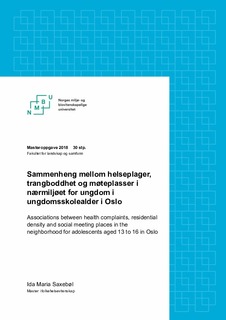| dc.contributor.advisor | Aamodt, Geir | |
| dc.contributor.advisor | Moen, Stein | |
| dc.contributor.author | Saxebøl, Ida Maria | |
| dc.coverage.spatial | Norway, Oslo | nb_NO |
| dc.date.accessioned | 2018-07-17T11:31:26Z | |
| dc.date.available | 2018-07-17T11:31:26Z | |
| dc.date.issued | 2018 | |
| dc.identifier.uri | http://hdl.handle.net/11250/2505813 | |
| dc.description.abstract | Hensikt: Hensikten med denne studien var å undersøke forskjeller i somatiske-, depressive- og angstsymptomer mellom de 15 bydelene i Oslo, samt å undersøke om disse symptomene hadde en sammenheng med trangboddhet. I tillegg ønsket vi å undersøke om tilgjengelige møteplasser i bydelene hadde en effekt på sammenhengen mellom somatiske-, depressive- og angstsymptomer og trangboddhet.
Metoder: Data fra ungdomsskoleelevene som deltok i Ung i Oslo 2015 ble koblet opp mot data om trangboddhet i alle bydelene i Oslo. Møteplass-variablene bestod av antall fritidsklubber, kultur-/idrettstilbud, parker og andre potensielle helsefremmende møteplasser i de 15 bydelene, som også ble koblet opp mot Ung i Oslo-datamaterialet.
Resultater: Vi fant signifikante forskjeller i forekomst av høyt nivå av de depressive- og angstsymptomer mellom Oslos 15 bydeler, den største forskjellen fant vi i forekomsten av depressive symptomer (fra 7,6 til 17,1%). Høyt nivå av depressive- og angstsymptomer ble funnet å ha en signifikant sammenheng med trangboddhet i bivariate analyser. Trangboddhet ble funnet å ha en signifikant sammenheng med høyt nivå av depressive- og angstsymptomer i regresjonsanalysen når SØS og antall fritidsklubber ble ekskludert fra analysene.
Konklusjon: Det er store forskjeller i forekomst av depressive- og angstsymptomer mellom bydelene i Oslo, og det er mulig at en del av denne variasjonen kan tilskrives forskjeller i trangboddhet. Tilgjengelighet av møteplasser i bydelen ser ikke ut til å ha betydning for forekomsten av selvrapporterte symptomer på fysiske- og psykiske plager blant ungdommer mellom 13-16 år i Oslo. | nb_NO |
| dc.description.abstract | Aim: The aim of this study was to explore city district differences in somatic-, depressive- and anxiety symptoms, and examine the association between the symptoms and residential density. We also wanted to investigate whether types of social meeting places could affect these associations.
Methods: Data from the cross-sectional Ung i Oslo study from 2015 were linked to residential density in the 15 city districts of Oslo to investigate the association between the variables. We also assessed whether different types of social meeting places in the city district, such as youth clubs, cultural-/sports clubs, parks and point of interest, could have an effect on the association. Results: There were significant differences between the city districts in prevalence of high levels of depressive- and anxiety symptoms, with depressive symptoms showing the widest range (from 7.6 to 17.1%). High levels of depressive- and anxiety symptoms were significantly associated with residential density in the bivariate analyses. Residential density was significantly associated with depressive- and anxiety symptoms in the regression analysis when SES and number of youth clubs were excluded from the analyses.
Conclusion: There are significant differences in prevalence of depressive- and anxiety symptoms between the city districts in Oslo, and it is possible that some of the effect can be attributed to differences in residential density. Available places to meet in the city district did not have an impact on prevalence of self- reported somatic- and mental health symptoms among adolescents aged 13-16 years in Oslo. | nb_NO |
| dc.language.iso | nob | nb_NO |
| dc.publisher | Norwegian University of Life Sciences, Ås | nb_NO |
| dc.relation.haspart | Kappe og artikkel | nb_NO |
| dc.rights | Attribution-NonCommercial-NoDerivatives 4.0 Internasjonal | * |
| dc.rights.uri | http://creativecommons.org/licenses/by-nc-nd/4.0/deed.no | * |
| dc.subject | Fysisk og psykisk helse | nb_NO |
| dc.subject | Ungdomshelse | nb_NO |
| dc.subject | Byutvikling | nb_NO |
| dc.subject | Adolescent health | nb_NO |
| dc.subject | Built environment | nb_NO |
| dc.subject | Somatic and mental health | nb_NO |
| dc.title | Sammenheng mellom helseplager, trangboddhet og møteplasser i nærmiljøet for ungdom i ungdomsskolealder i Oslo | nb_NO |
| dc.title.alternative | Associations between health complaints, residential density and social meeting places in the neighborhood for adolescents aged 13 to 16 in Oslo | nb_NO |
| dc.type | Master thesis | nb_NO |
| dc.subject.nsi | VDP::Samfunnsvitenskap: 200 | nb_NO |
| dc.source.pagenumber | 78 | nb_NO |
| dc.description.localcode | M-FOL | nb_NO |

